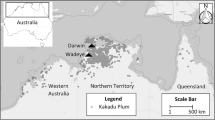Abstract
Cassava is the most important food for poor people in the tropics. Its roots are used either fresh or in numerous processed forms. It is a shrub with tuberous adventitious roots arising from stem cutting. Wild relatives of cassava are perennial and vary in growth pattern from nearly acaulescent subshrubs to small trees. They have been used as a source of useful characters such as high protein content, apomixis, resistance to mealy bug and mosaic disease and tolerance to drought. Cultivars stem from interspecific hybrids of cassava with M. glaziovii Muell.-Arg. are cultivated now in about 4 millions hectars in Nigeria. Indigenous clones are potential source of B-carotene and lycopene.









Similar content being viewed by others
References
Anonymous (1989) Central tuber crops research institute annual report. Thruvandrum, 1989, 86 pp. 2
Beck BD (1986) Cassava trials on Moor plantation. Rep. Dept. Agric. Res. Nigeria, 1958–1959
Beck BC (1986) Cassava trials on moor plantation. Rep. Dept. Agric. Res. Nigeria, 1958–1959
Bolhuis GG (1966) Influence of length of the illumination period on root formation in cassava. Neth J Agric Sci 14:151–262
Bruijn GH (1971) A study on cyanogenetic character of cassava (Manihot esculenta Crantz), Mededelingen Landbouwhogesschool Wangeningen, 140 pp
Coursey DG, Hybnes PH (1970) Root crops and their potential as food in the tropics. World crops 22(5):261–265
Dixon AGOA, Brandyop R, Ortiz R (2003) Cassava from poor farmers crop to Pacesetters of African Rural Development. Chronica Horticulturae 43 3–69 FAO Yearbook 2002
FAO Yearbook, 2003, Rome
Lancaster PA, Ingram JS, Lim MY, Coursey DG (1982) Traditional cassava based foods: survey of processing techniques. Econ Bot 36(1):12–45
Magoon ML, Joss JS, Appan SG (1966) Cytomorphology of interspecfic hybrid between cassava and ceara rubber. Chromosome Information Service (Japan) pp 8–10
Nassar NMA (1978a) Conservation of the genetic resouces of cassava (Manihot esculenta Crantz): determination of wild species localites with emphasis on probable origin. Econ Bot 32:311–320
Nassar NMA (1978b) Genetic resouces of cassava: chromosome behaviour in some Manihot species. Ind J Genet. 38(1):135–137
Nassar NMA (1978c) Hydrocyanic acid content in some wild Manihot (cassava) species. Can J Plant Sci 58:577–578
Nassar NMA (1986) Genetic variation of wild Manihot species native to Brazil and its potential for cassava improvement. Field Crops Res 13:177–184
Nassar NMA (1989) Broadening the genetic base of cassava, Manihot esculenta Crantz by interespecific hybridization. Can J Plant Sci 69:1071–1073
Nassar NMA (1991) Production of triploid cassava, Manihot esculenta Crantz by hybrid diploid gametes. Field Crops Res 13:173–182
Nassar NMA (1995) Development and selection for apomixis in cassava Manihot esculenta Crantz. Can J Plant Sci 4:857–858
Nassar NMA (1997) Development of cassava interespecific hybrids for savana (cerrado) conditions. J Root Crops 22:9–17
Nassar NMA (1999) Cassava, Manihot esculenta Crantz genetic resources: their collection, evaluation and manipulation. Adv Agronomy 69:179–230
Nassar NMA (2000a) Wild Cassava, Manihot spp.: biology and potentialities for genetic improvement. Genet Mol Biol 23:201–212
Nassar NMA (2000b) Cytogenetics and Evolution of Cassava (Manihot esculenta Crantz). Genet Mol Biol 23:41003–41014
Nassar NMA (2001) The nature of apomixis in cassava (Manihot esculenta Crantz). Hereditas 134:185–187
Nassar NMA (2004) Polyploidy, Chimera and fertility of interspecific cassava, Manihot esculenta Crantz. Indian J Genet Plant Breed 62:132–133
Nassar NMA, Costa CP (1978) Tuber formation and protein content in some wild cassava species native to Brazil. Experientia (Basel) 33:1304–1306
Nassar NMA, Dorea G (1982) Protein contents of cassava cultivars and its hybrid with Manihot species. Turrialba 32(4):429–432
Nassar NMA, Teixeira (1983) Seed germination of wild cassava species (Manihot spp.). A quebra de barreira da semente das espécies selvagens da mandioca. Manihot spp. (In Portuguese). Ciência e Cultura 35(5)630–632
Nassar NMA, Freitas M (1997) Prospects of polyploidizing cassava. Manihot esculenta Crantz, by unreduced microspores. Plant Breed 116:195–197
Nassar NMA, Nassar Hala NM, Vieira C, Carvalho A (1996a) Induction of a productive aneuploid in cassava, Manihot esculenta Crantz. Braz J Genet 19:123–125
Nassar NMA, Carvalho A, Vieira C (1996b) Overcoming barries between cassava Manihot esculenta Crantz and wild relative. M. pohiil Warwa. Braz J Genet 19:617–620
Nassar NMA, Vieira C, Grattapaglia D (1998a) Molecular and embryonic evidence of apomix in cassava interspecific hybrids (Manihot spp.). Can J Plant Sci 78:348–352
Nassar NMA, Vieira C, Grattapaglia D (1998b) Evidence of apomixis in cassava (Manihot esculenta Crantz). Genet Mol Biol 21:527–530
Nassar NMA, Santos E, David SRO (2000) The transference of apomixis genes from Manihot neusana Nassar to cassava, M. esculenta Crantz. Hereditas 132:167–170
Nassar NMA, Vizzotto CA, da Silva HL, Schwartz CA, Pres Junior OR (2005) Geneconserve www.geneconserve.pro.br articles , issue no. p :267–283
Ortiz R (2004) Acknowledgement : www.geneconserve.pro.br/iita2.gif
Rogers DJ (1963) Studies of Manihot esculenta Crantz (Cassava) and related species, Bull Torrey Bot 90:43–54
Rogers DJ (1965) Some botanical and ethnological considerations of Manihot esculenta Crantz. Econ Bot 19:369–377
Rogers DJ, Appan SG (1973) Manihot, Manihotoides (Euphorbiaceae) Hafner Press, New York, 272
Storey HH, Nichols RFW (1938) Studies on the mosaic disease of cassava. Ann Appl Biol 25:790–806
Williams CN, Gazhali SM (1969) Growth and productivity of tapioca (Manihot utilissima) 1, Leaf characteristics and yield. Exp Agric 5:183–194
Acknowledgements
This work is being supported by the Brazilian National council for Scientific Development (CNPq), Brasilia. The above-mentioned living collection was established at the Universidade de Brasilia, with the help of the Canadian International Development Research Center (IDRC), Ottawa in the years 1976-1982 to whom this author is grateful.
Author information
Authors and Affiliations
Corresponding author
Rights and permissions
About this article
Cite this article
Nassar, N.M.A. Wild and indigenous cassava, Manihot esculenta Crantz diversity: An untapped genetic resource. Genet Resour Crop Evol 54, 1523–1530 (2007). https://doi.org/10.1007/s10722-006-9144-y
Received:
Accepted:
Published:
Issue Date:
DOI: https://doi.org/10.1007/s10722-006-9144-y




